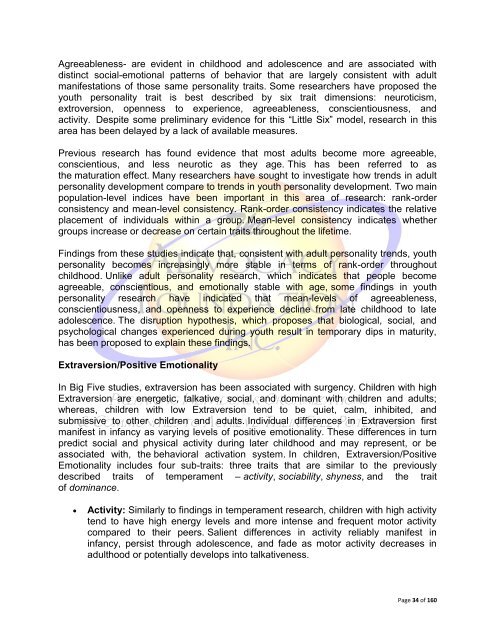The Gift of Introversion
The Gift of Introversion
The Gift of Introversion
Create successful ePaper yourself
Turn your PDF publications into a flip-book with our unique Google optimized e-Paper software.
Agreeableness- are evident in childhood and adolescence and are associated with<br />
distinct social-emotional patterns <strong>of</strong> behavior that are largely consistent with adult<br />
manifestations <strong>of</strong> those same personality traits. Some researchers have proposed the<br />
youth personality trait is best described by six trait dimensions: neuroticism,<br />
extroversion, openness to experience, agreeableness, conscientiousness, and<br />
activity. Despite some preliminary evidence for this “Little Six” model, research in this<br />
area has been delayed by a lack <strong>of</strong> available measures.<br />
Previous research has found evidence that most adults become more agreeable,<br />
conscientious, and less neurotic as they age. This has been referred to as<br />
the maturation effect. Many researchers have sought to investigate how trends in adult<br />
personality development compare to trends in youth personality development. Two main<br />
population-level indices have been important in this area <strong>of</strong> research: rank-order<br />
consistency and mean-level consistency. Rank-order consistency indicates the relative<br />
placement <strong>of</strong> individuals within a group. Mean-level consistency indicates whether<br />
groups increase or decrease on certain traits throughout the lifetime.<br />
Findings from these studies indicate that, consistent with adult personality trends, youth<br />
personality becomes increasingly more stable in terms <strong>of</strong> rank-order throughout<br />
childhood. Unlike adult personality research, which indicates that people become<br />
agreeable, conscientious, and emotionally stable with age, some findings in youth<br />
personality research have indicated that mean-levels <strong>of</strong> agreeableness,<br />
conscientiousness, and openness to experience decline from late childhood to late<br />
adolescence. <strong>The</strong> disruption hypothesis, which proposes that biological, social, and<br />
psychological changes experienced during youth result in temporary dips in maturity,<br />
has been proposed to explain these findings.<br />
Extraversion/Positive Emotionality<br />
In Big Five studies, extraversion has been associated with surgency. Children with high<br />
Extraversion are energetic, talkative, social, and dominant with children and adults;<br />
whereas, children with low Extraversion tend to be quiet, calm, inhibited, and<br />
submissive to other children and adults. Individual differences in Extraversion first<br />
manifest in infancy as varying levels <strong>of</strong> positive emotionality. <strong>The</strong>se differences in turn<br />
predict social and physical activity during later childhood and may represent, or be<br />
associated with, the behavioral activation system. In children, Extraversion/Positive<br />
Emotionality includes four sub-traits: three traits that are similar to the previously<br />
described traits <strong>of</strong> temperament – activity, sociability, shyness, and the trait<br />
<strong>of</strong> dominance.<br />
<br />
Activity: Similarly to findings in temperament research, children with high activity<br />
tend to have high energy levels and more intense and frequent motor activity<br />
compared to their peers. Salient differences in activity reliably manifest in<br />
infancy, persist through adolescence, and fade as motor activity decreases in<br />
adulthood or potentially develops into talkativeness.<br />
Page 34 <strong>of</strong> 160

















